 
|
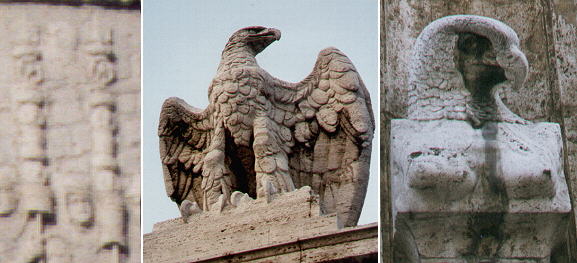 | ||
The Roman ensigns had on their top an eagle representing Rome. These symbols were held high by a special group of soldiers and during the battles they indicated the location of the commanding officers and they gave reassurance to the Roman legionaries. The choice of the eagle as the symbol of command was widespread among ancient civilizations. In Rome, according to the legend, this choice was due to the fact that Romulus, the founder of Rome, first saw an eagle, when he was competing (in a sort of modern bird-watching exercise) with his brother Remus for who should be the founder of the new town. The Roman eagle was usually represented with open wings and it was often inscribed within an oak-wreath (see relief in SS. Apostoli). The Roman eagle was resurrected by Mussolini in the 1930s and several buildings of that period were decorated with eagles. Most of the eagles of Rome, however, are a reminder of Paulus V (1605-21) and his family: Villa Borghese, Palazzo Borghese, Acqua Paola, are some of the monuments decorated with their eagles (and dragons). A chequered eagle was the symbol of Innocentius III (1198-1216) and Innocentius XIII (1721-24): their eagle can be seen at the foot of the Spanish Steps and on the Obelisk in Piazza S. Pietro. Innocentius XI (1676-89), Alexander VIII (1689-91), Leo XII (1823-29) and Pius XI (1922-39) were other popes who had an eagle in their coat of arms.
The dove is the second most represented bird in Rome: see the page on this heraldic symbol of Innocentius X (1644-55). A dove appears also in the coat of arms of Pius XII (1939-58).
Other birds can be seen in Palazzo Falconieri (falcons), Palazzo Rondanini (swallows) and S. Maria in Publicolis (swans).
The Roman She - Wolf
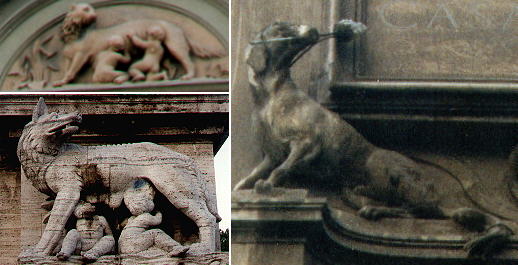 | ||
The Romans associated the wolf with the cult of Mars, the god of war, so the legend of Romulus and Remus nurtured by a she-wolf symbolized the warrior spirits of the Romans. Seeing a wolf before a battle was a sign of forthcoming victory. The Etruscans, before the Romans, had this positive opinion of the wolf and the bronze statue of a she-wolf which is the symbol of the city of Rome is an Etruscan statue to which Antonio del Pollaiolo added the twins in the XVth century. The she-wolf in the act of nurturing the twins can be seen in many buildings as a homage to Rome: this scene is called Lupercale or Natale di Roma (Roman Christmas) (see the section of the Grand View of Rome by Giuseppe Vasi showing this scene).
In ancient Rome dogs were mainly represented in association with Diana, the hunting goddess, but the only dogs now on display in the streets of Rome are related to Dominican monasteries (SS. Domenico e Sisto) or institutions (Biblioteca Casanatense near S. Maria sopra Minerva) as the Latin word Dominicanus was split into Domini (of the Lord) and Canis (dog) and in this way a dog holding a torch became the symbol of this religious order. Benedictus XIII (1724-30) had a Dominican dog in his coat of arms.
Horses
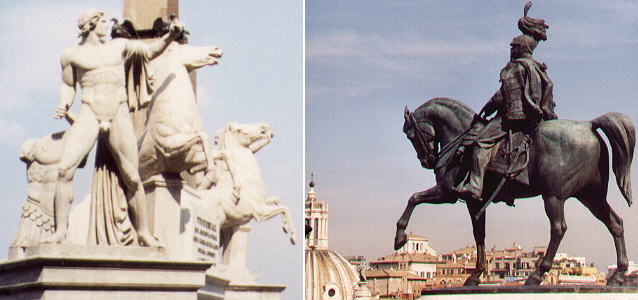 | ||
The Dioscuri (from the Greek Dios Kuroi, sons of Zeus), Castor and Pollux (or Polydeuces), demi-gods of the Greek mythology were worshipped by the Romans too and Virgil celebrated them in his poem. Their miraculous appearance in a battle secured victory for the Romans. They were represented as horse-tamers in the statues in Piazza del Campidoglio and in Piazza del Quirinale: a memory of the horse-tamers can be also seen in the statues of Fontana di Trevi. Horses are obviously shown in equestrian statues, first of all in the statue of Marcus Aurelius. Other equestrian statues are those showing Constantine (by Bernini) and Charlemagne in St Peter's, Garibaldi in Piazzale del Gianicolo and King Victor Emmanuel II in Piazza Venezia (it is the largest statue of Rome). Bernini sculptured another horse in Fontana dei Quattro Fiumi.
Lions
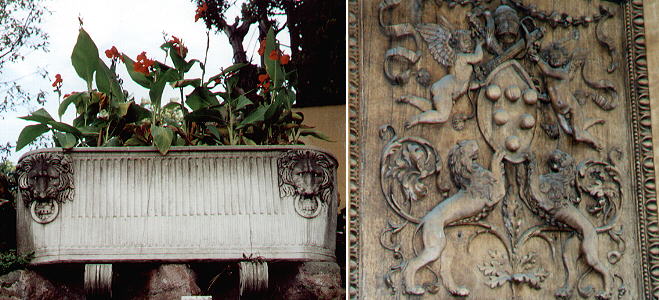 | ||
The lion, the king of the animals, was mainly associated by the Romans with the myth of Hercules, who was always portrayed wearing a lion skin: this association did not get lost and can be seen again in a late Renaissance palace (Palazzo Madama). Lions protected the dead in the Roman sarcophagi (see image above and another sarcophagus in Palazzo Mattei di Giove). Egyptian lions decorate the obelisk in Piazza del Popolo and the steps leading to Palazzi del Campidoglio. The Romans liked in particular scenes showing the lion in the act of hunting a deer and some of these reliefs can be seen in Casa di Lorenzo Manilio and in Strada dell'Orso. The lion is the most recurring animal in heraldry and many popes had a lion in their coat of arms: Paulus II (1464-71), Adrianus VI (1522-23), Sixtus V (1585-90) (whose lions decorated many churches and palaces), Innocentius XI (1676-89), Pius VIII (1829-30) and Pius IX (1846-78). Leo X (1513-21) wanted lions bringing to mind his name in a church he rebuilt (S. Maria in Domnica) and even in the shutters of the papal apartment. Bernini sculptured a lion in the act of drinking in Fontana dei Quattro Fiumi.
 | ||
More domestic lions decorate the windows of many XVIIIth century buildings. They have little of the king of the animals; they seem intent on chatting and watching the passers-by.
Bears and other wild animals
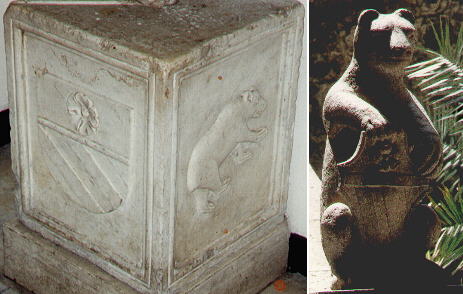 | ||
The bear was known by all ancient civilizations including the Roman one, but it was not as popular as other animals. In Rome statues or reliefs showing bears are almost entirely associated with the Orsini family (Orso in Italian means bear). Other wild animals were portrayed by Bernini in Fontana dei Quattro Fiumi (an alligator and a snake), in the obelisk in Piazza della Minerva (an elephant) and in Fontana del Tritone (dolphins). Bernini added also the tortoises to Fontana delle Tartarughe.
Oxen and other domestic animals
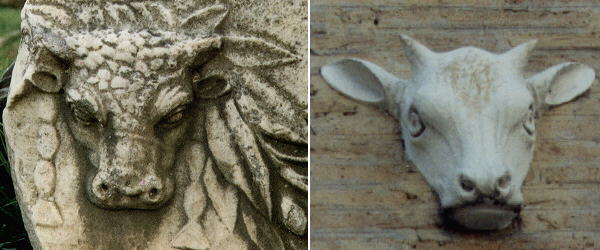 | ||
A frieze the Romans frequently used to decorate their buildings was based on skulls of oxen, a memory of the sacrificial role of these animals (these friezes can still be seen in the Tomb of Cecilia Metella and in Porta S. Lorenzo). The image above shows the head of an oxen ready for the sacrifice. Callistus III (1455-58) and his nephew Alexander VI (1492-503) had cows in their coats of arms. Palazzo Vitelli in Campo Marzio is decorated with heads of young calves, because Vitelli means veal. Goats were a very common animal in Rome until the beginning of the XIXth century and many street names have references to them. A part of Campidoglio was called Monte Caprino (Capra means goat) because goats were brought there for their pasture. Today the only goat left is on the top of Palazzo Altemps.
Heraldic Symbols and Imaginary Animals
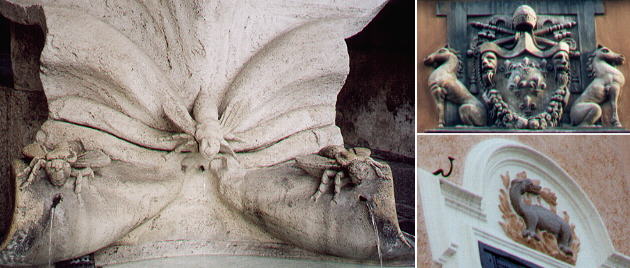 | ||
During the pontificate of Urbanus VIII, Rome became a beehive: the heraldic bees of the pope made their appearance everywhere: the fountain named after them (by Bernini) was their swan song: it was completed in 1644, the year the pope died. Paulus III (1534-50) had horses as a secondary heraldic symbol and they appear next to his formal coat of arms in a house in Via Giulia. S. Luigi dei Francesi is decorated with reliefs showing salamanders, lizard-like animals supposed to live in fire. This very unusual subject (the heraldic symbol of Francis I) decorates also the windows of a house near S. Onofrio.
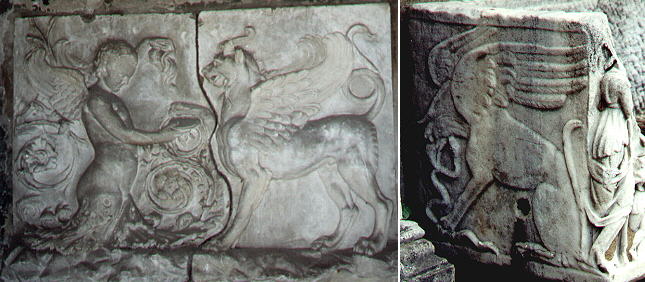 | ||
The Romans inherited from the Etruscans some imaginary animals (sphynx, chimera), the appearance of which was modified when the Romans came in contact with the Greeks and the Egyptians. Two popes, Gregorius XIII (1572-85) and Paulus V (1605-21) had a dragon in their coat of arms and this explains why there are so many dragons in Rome: you can see them in the following pages: The Dragon and the Calendar (Gregorius XIII) and Dragons and Eagles (Paulus V).
![]()
Go to my Home
Page on Baroque Rome or to my Home Page on Rome
in the footsteps of an XVIIIth century traveller.
All images © 1999 - 2003 by Roberto Piperno. Write to romapip@quipo.it
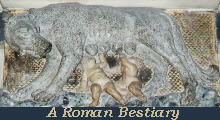 A Roman Bestiary
A Roman Bestiary